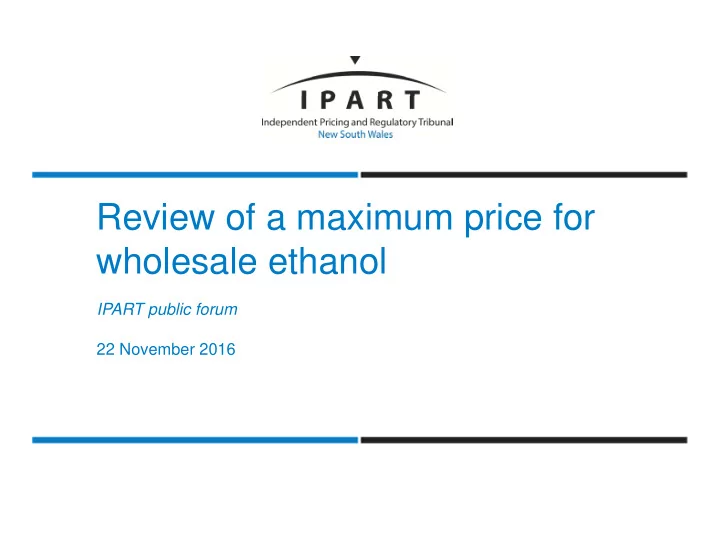

Review of a maximum price for wholesale ethanol IPART public forum 22 November 2016
Framework for our draft recommendations No regulation needed Degree of consumer Light-handed choice for approach retail fuel Cost-based approach Extent of competition in the wholesale ethanol market 2
Light-handed approach Consumers have a relatively high degree of choice between regular unleaded petrol, premium unleaded petrol (PULP) and E10 at most service stations Emerging competition between the three ethanol producers in eastern Australia Relatively low oil/petroleum prices are also imposing a constraint on wholesale ethanol prices Under these conditions we consider a light-handed approach to recommending a maximum price is appropriate 3
Import parity price (IPP) methodology Most suitable light-handed methodology Our proposed IPP methodology includes: the international market price transport costs landing costs in Australia, including relevant excise tax storage and handling costs in Australia 4
IPP methodology This methodology would: allow emerging competition in the wholesale ethanol market to continue to develop support a sustainable biofuels industry We don’t expect that ethanol prices will rise to the level of our recommended maximum price. We expect the ethanol market will continue to set prices below the recommended maximum 5
Annual monitoring and reporting We’ve been asked to monitor and report on the retail market for E10 We’re also proposing to monitor consumer choice for retail fuel and the wholesale ethanol market Our assessment would consider whether a light- handed, cost-based, or no regulation approach is most appropriate We will consult separately on our approach. Issues paper in March 2017 First monitoring report for 2016-17 financial year 6
Efficient Cost Review of Port Efficient Costs of New Entrant Services to Cruise Ships Ethanol Producers Approach and Key Findings Approach and Key Findings August 23 2016 November 22, 2016
Development of Production Cost Models Efficient Cost of New Entrant November 22, 2016 Page 8 Ethanol Producers
Example: Ethanol from Grain for new entrants 1. Typical production pathway: Efficient Cost of New Entrant November 22, 2016 Page 9 Ethanol Producers
Example: Ethanol from Grain for new entrants 2. Estimated feedstock availability and yield: Wheat exports Efficient Cost of New Entrant November 22, 2016 Page 10 Ethanol Producers
Example: Ethanol from Grain for New Entrants 3. Estimated cost of production and delivery: Efficient Cost of New Entrant November 22, 2016 Page 11 Ethanol Producers
Comparative Delivered Ethanol Costs The lowest cost ethanol is made from wheat (starch). • Cane trash appears to be the cheapest feedstock available, but high capital • and production costs make production from cane trash costly. Comparative Cost of Production ($/L) Comparative Cost of Feedstock ($/L) Efficient Cost of New Entrant November 22, 2016 Page 12 Ethanol Producers
Impact of scale on production costs The analysis has used a standardised plant size for comparison (100 ML pa). • Increasing plant size provides economies of scale, reducing production costs. • Efficient Cost of New Entrant November 22, 2016 Page 13 Ethanol Producers
Production cost curve for Australia The production cost using feedstock availability and production costs indicates that about 1,300 ML of ethanol could (theoretically) be produced at an average cost of $0.58 per litre. The cost per litre goes up from there. Efficient Cost of New Entrant November 22, 2016 Page 14 Ethanol Producers
Conclusions The capital investment involved is significant, and some form of market security • is likely to be necessary to encourage investments in ethanol production. Proponents have noted that some form of market security would encourage the • investment required. Security of access to feedstocks is already an issue and may become more • significant if market prices for those feedstocks increase. This risk could be mitigated through long-term supply contracts, grower participation in ethanol production directly, or via co-operatives. Development of the biofuels sector would encourage economic development in • the rural communities around each plant. The cost of ethanol production may reduce in the future as technology • improves, and cellulosic production in particular may become more attractive. This form of production is considered a medium to long term option. Efficient Cost of New Entrant November 22, 2016 Page 15 Ethanol Producers
Thank You mike.stoke@aecom.com simon.ward@aecom.com
17 Q&A
IPP methodology In the Draft Report we said we would prefer to use the lower of the US and Brazilian ethanol IPP We were only aware of a freely available source for Brazilian mill-gate prices, not for US prices Have since found a free source for US mill-gate prices (US Department of Agriculture) 18
US source for mill-gate prices Weekly average ethanol prices from nine top producing states, including: ‘Eastern Corn Belt’ (incl Illinois), Iowa, Kansas, Minnesota, Wisconsin, Nebraska, South Dakota Propose to use an average of prices from these states Preliminary analysis suggest cost of US land transport and sea freight from US Gulf to Australia are similar to that of ethanol from Brazil 19
IPART IPP based on US vs Brazilian ethanol prices Assumes similar shipping costs, but customs value duty of: 0 cpl on US ethanol 3 cpl on Brazilian ethanol For period 7 Nov to 4 December Brazil IPP: 140 AU c/litre US IPP: 115 AU c/litre 20
Recommend
More recommend